Related Research Articles

The Royal College of Music is a conservatoire established by royal charter in 1882, located in South Kensington, London, UK. It offers training from the undergraduate to the doctoral level in all aspects of Western Music including performance, composition, conducting, music theory and history, and has trained some of the most important figures in international music life. The RCM also undertakes research, with particular strengths in performance practice and performance science.
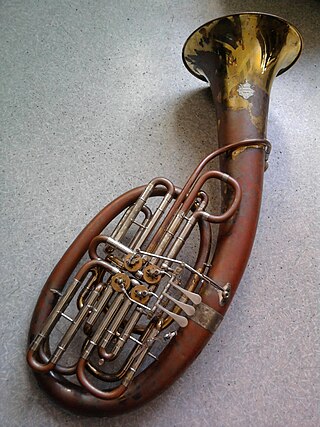
The Wagner tuba is a four-valve brass instrument commissioned by and named after Richard Wagner. It combines technical features of both standard tubas and French horns, though despite its name, the Wagner tuba is more similar to the latter, and usually played by horn players. Wagner commissioned the instrument for his four-part opera cycle Der Ring des Nibelungen, where its purpose was to bridge the acoustical and textural gap between the French horn and trombone.
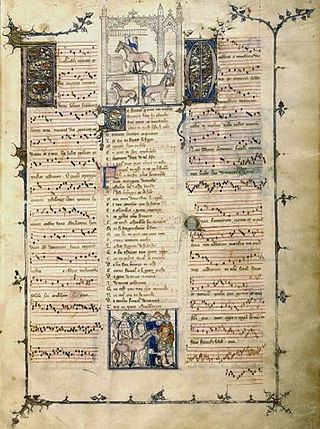
Ars nova refers to a musical style which flourished in the Kingdom of France and its surroundings during the Late Middle Ages. More particularly, it refers to the period between the preparation of the Roman de Fauvel (1310s) and the death of composer Guillaume de Machaut in 1377. The term is sometimes used more generally to refer to all European polyphonic music of the fourteenth century. For instance, the term "Italian ars nova" is sometimes used to denote the music of Francesco Landini and his compatriots, although Trecento music is the more common term for the contemporary 14th-century music in Italy. The "ars" in "ars nova" can be read as "technique", or "style". The term was first used in two musical treatises, titled Ars novae musicae by Johannes de Muris, and a collection of writings attributed to Philippe de Vitry often simply called "Ars nova" today. Musicologist Johannes Wolf first applied to the term as description of an entire era in 1904.
Abū Isḥāq Ibrāhīm al-Mawṣilī was an Arab musician of Persian origin who was among the greatest composers of the early Abbasid period. After Arab and Persian musical training in Ray, he was called to the Abbasid capital of Baghdad where he served under three successive Abbasid caliphs: Al-Mahdi, Al-Hadi and Harun al-Rashid. He became particularly close with the latter and emerged as the leading musician of his time. He championed the conservative school of Arab music against progressives such as Ibn Jami. His son and student Ishaq al-Mawsili would succeed him as the leader of the conservative tradition and his other pupils included the musicians Mukhariq, Zalzal and Ziryab. He appears in numerous stories of One Thousand and One Nights.
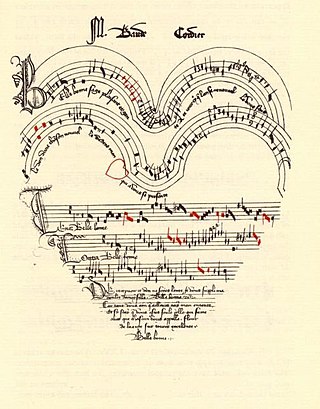
Baude Cordier was a French composer in the ars subtilior style of late medieval music. Virtually nothing is known of Cordier's life, aside from an inscription on one of his works which indicates he was born in Rheims and had a Master of Arts. Some scholars identify him with Baude Fresnel, a harpist and organist in the court of Philip the Bold, though other scholars have rejected this.
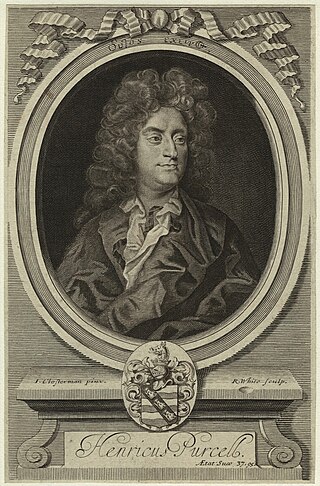
Orpheus Britannicus is a collection of songs by Henry Purcell, published posthumously in London in two volumes, the first in 1698 and the second in 1702. In the preface to the first volume Henry Playford, the printer of the volume and the son of the music publisher John Playford, praises Purcell's setting of English texts.
Manṣūr Zalzal al-Ḍārib or simply Zalzal, was an Iranian musician during the early Abbasid period. The renowned musician Ishaq al-Mawsili was his student; he declared Zalzal to be the most outstanding lutenist of his time.
George Michael Sinclair Kennedy CBE was an English music critic and author who specialized in classical music. For nearly two decades he was the chief classical music critic for both The Daily Telegraph (1986–2005) and The Sunday Telegraph (1989–2005). A prolific writer, he was the biographer of many composers and musicians, including Vaughan Williams, Elgar, Barbirolli, Mahler, Strauss, Britten, Boult and Walton. Other notable publications include writings on various musical institutions, the editing of music dictionaries as well as numerous articles for The New Grove Dictionary of Music and Musicians and the subsequent Grove Music Online.

Carl Michael Alfred Steinberg was an American music critic and author who specialized in classical music. He was best known, according to San Francisco Chronicle music critic Joshua Kosman, for "the illuminating, witty and often deeply personal notes he wrote for the San Francisco Symphony's program booklets, beginning in 1979." He contributed several entries to the New Grove Dictionary of Music and Musicians, wrote articles for music journals and magazine, notes for CDs, and published a number of books on music, both collected published annotations and new writings.

The Ospedale degli Incurabili is a large sixteenth-century hospital building on the Fondamenta delle Zattere, in the sestiere of Dorsoduro, in Venice in north-eastern Italy. Today it is occupied by the Accademia di Belle Arti di Venezia. It was built in the second half of the sixteenth century; the church – which no longer exists – may have been designed by Jacopo Sansovino.
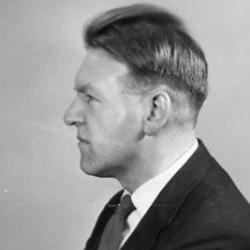
Gilbert Reaney was an English musicologist who specialized in medieval and Renaissance music, theory and literature. Described as "one of the most prolific and influential musicologists of the past century", Reaney made significant contributions to his fields of expertise, particularly on the life and works of Guillaume de Machaut, as well as medieval music theory.

Trevor Noël Goodwin was an English music critic, dance critic and author who specialized in classical music and ballet. Described as having a "rare ability to write about music and dance with equal distinction", for 22 years Goodwin was Chief music and dance critic for the Daily Express. He held criticism posts at many English newspapers, including the News Chronicle, Truth and The Manchester Guardian among others; from 1978 to 1998 he also reviewed performances for The Times. Goodwin wrote an early history of the Scottish Ballet and was coauthor for two books: London Symphony: Portrait of an Orchestra with Hubert J. Foss and a Knight at the Opera with Geraint Evans.
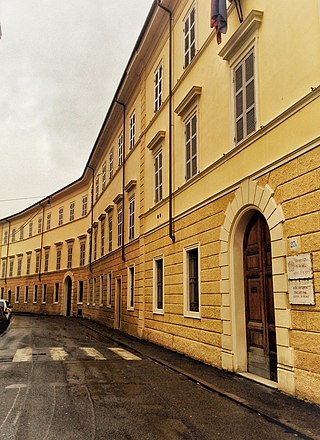
The Conservatorio di Musica Arrigo Boito, better known in English as the Parma Conservatory, is a music conservatory in Parma, Italy. It was originally established as the Regia Scuola di Canto, a school for singing in 1819 by Marie Louise, Duchess of Parma, and expanded into a conservatory of music in 1825. In 1840 instrumental music instruction began, followed by the addition of music composition, conducting, and other musical studies.
References
- ↑ "National Training School of Music". Grove Music Online. Oxford University Press. 2002. doi:10.1093/gmo/9781561592630.article.19615.
- ↑ Joyce Kennedy; Michael Kennedy; Tim Rutherford-Johnson, eds. (30 August 2012). "National Training School of Music". The Oxford Dictionary of Music (6 ed.). Oxford University Press. ISBN 9780199578108.
- 1 2 3 4 5 Wright, David "The South Kensington Music Schools and the Development of the British Conservatoire in the Late Nineteenth Century", Journal of the Royal Musical Association, Vol. 130, No. 2 (2005), pp. 236–282 (subscription required)
- 1 2 "The Proposed College for Music", The Musical Times and Singing Class Circular, Vol. 23, No. 467 (January 1882), pp. 17–18 (subscription required)
- ↑ "Royal College of Music", The Musical Times and Singing Class Circular, Vol. 24, No. 484 (June 1883), pp. 309–310 (subscription required)
- ↑ Rainbow, Bernarr and Anthony Kemp. "London – Educational establishments", Grove Music Online, Oxford Music Online, accessed 4 January 2012 (subscription required)
- ↑ "Sir Walter Alcock: Great Church Organist", The Times, 12 September 1947, p. 4
- ↑ Evans, Robert; Humphreys, Maggie (1 January 1997). Dictionary of Composers for the Church in Great Britain and Ireland. London: Mensell. p. 67. ISBN 0720123305.
Studied from 1876 at the National Training School of Music where his teachers were Franklin Taylor, Ebenezer Prout, Arthur Sullivan and John Stainer.
- ↑ "Eugene D'Albert: A Biographical Sketch", The Musical Times , vol. 45, issue 741, 1 November 1904, pp. 697–700. Retrieved 28 August 2023
- ↑ Patton, Faye. "Ewart (née Donaldson), Florence Maud", Grove Music Online, Oxford University Press, 2001 (subscription required)
- ↑ "Her Majesty's Theatre". The Morning Post . June 4, 1877. p. 6.
- ↑ Sparks, Paul. "Biography". www.claraross.co.uk. Retrieved 2024-01-23.
- ↑ Guy Warrack, revised by Christopher Kent (2001). "Bridge, Sir (John) Frederick". Bridge, Sir (John) Frederick. Grove Music Online. Oxford University Press. doi:10.1093/gmo/9781561592630.article.03978.
- ↑ E.D. Mackerness (2001). "Carrodus, John (Tiplady)". Grove Music Online. Oxford University Press. doi:10.1093/gmo/9781561592630.article.05020.
- ↑ "Eaton Faning". The Musical Times . 42 (702): 513–26. August 1901. doi:10.2307/3366186. JSTOR 3366186 . Retrieved 23 June 2010.
- ↑ W. B. Henshaw (2003). "Stephen Kemp". Biographical Dictionary of the Organ. Bardon Music.(subscription required)
- ↑ Bernarr Rainbow (2001). "Monk, William Henry". Grove Music Online. Oxford University Press. doi:10.1093/gmo/9781561592630.article.18963.
- ↑ Rosemary Williamson (2001). "Prout, Ebenezer". Grove Music Online. Oxford University Press. doi:10.1093/gmo/9781561592630.article.22446.
- ↑ George Grove, revised by Jean Mary Allan (2001). "Taylor, Franklin". Grove Music Online. Oxford University Press. doi:10.1093/gmo/9781561592630.article.27588.
- ↑ "The Art Divine". The Ogden Standard. February 26, 1885. p. 3. Retrieved July 25, 2019– via Newspapers.com.